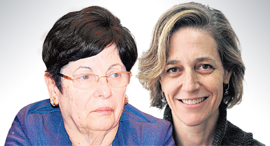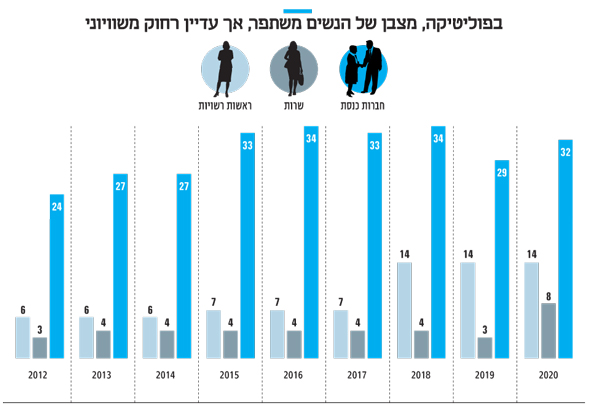
Contrary to what is commonly thought about the trends in Israeli society, the representation of women in prestigious professions has been on a downward trend or stepping in place in recent years. The representation of women in the medical profession, for example, dropped from a peak of 45% in 2015 to only 39% in 2018. The representation of women in the legal profession decreased from 47% in 2016 to only 44% in 2018. This is according to the Gender Equality Index of the Center for the Advancement of Women in the Public Arena at the Van Leer Institute in Jerusalem, which is published today for the eighth time.
The index examines the trends in inequality in building men and women over the years. The data on the decline in the representation of women in the prestigious professions are particularly surprising in light of the increase in the representation of women in departments in the academic institutions that teach these professions.
 Right: Head of Public Health Sharon Elrai Price and retired Supreme Court President Miriam Naor. Decrease in female representation Photo: Yair Sagi
Right: Head of Public Health Sharon Elrai Price and retired Supreme Court President Miriam Naor. Decrease in female representation Photo: Yair Sagi
The director of the ‘Know’ information center on women and gender and one of the index editors, Hadas Ben Eliyahu, explains the decline in the high birth rate in Israel and the fact that prestigious professions require many hours of work. “In Israel, productivity is three times higher than in developed countries. This creates an unusual burden of transparent work – care and housework. There is almost no change in the division of work at home and this affects the ability of women to integrate into these professions.”
Other prestigious professions in which female representation is in a similar situation are engineering with a rate of 23% stepping in place in recent years. On the other hand, the representation of women in high-tech decreased from a peak of 37% in 2012 to 35% in 2018, when already in 2000, 34% of high-tech workers were women.
The entire gender index also steps in place from 2012, between 0.87 and 0.89, without improvement. The index weighs the gaps between men and women in a range of areas of life such as political and economic power, the labor market, education, domestic violence, transparent work at home and more. The index examines the gaps between men and women, rather than the degree of integration of women in different fields, so that even if there is an improvement in the combination of women in a particular field, if the representation of men increases equally, it will be considered a step in place.
One area where women lead, and this is very much to their detriment, is poverty. 62% of the recipients of the Social Security income support pension are women. This is a very slight improvement compared to 63% in 2012. 43% of women earned in 2018 up to the minimum wage compared to 28% of men. One reason for this is that women head 84% of single-parent families. The incidence of poverty in men fell from 17.5% in 2012 to 15.5% in 2012. This also for women decreased during this period by 2% – but from 20% to 18%. The fact that unemployment in Corona is hurting women much more will probably lead to a significant deterioration.

The current giant government has had at least one important contribution. It has 8 services, 25% of the government. This is double the number of services from any other government and also a higher percentage. In the area of gaps in economic and political power there is no clear trend. The level of inequality has been fluctuating from 2013 between 0.75 and 0.85, while in 2018 there was a slight increase in inequality. It is likely that this figure was doubled by the doubling of the number of local council heads from 7 to 14 in 2018. The figure means that the council chairmanship rate has increased from 2.7% to 5.4%, so the situation is still awkward but a little less so.
In the previous term of the Knesset, periods were recorded in which there were 34 MKs, ie 28% of all MKs. In the current Knesset there are 32 MKs, ie 27%. Although there are 8 services there are only 5 CEOs who make up 15% of all CEOs in the government. This is much less than 2014 (the period of the Netanyahu-Lapid-Bennett government) in which there were 7 CEOs who constituted 24%.
The proportion of women on board in public companies is 23%, compared with 44% in government companies. “The editors of the index state that the gap: emphasizes the effect of legislation that requires equal gender representation that exists in relation to government companies but not public ones.”
This year, the psychometric score was included in the index for the first time. It turns out that despite the very large gap in favor of women in the area of eligibility for matriculation and academic degrees, there is a significant gap to their detriment in psychometric score. The average score for men is 510 compared to 486 for women.
Ben Eliyahu says “there is a gender discourse but the gender gap is not narrowing. Everyone is talking about fighting violence against women, but in practice very little has been done.” According to her, in order to reduce the gaps, legislation is needed that requires equality. “